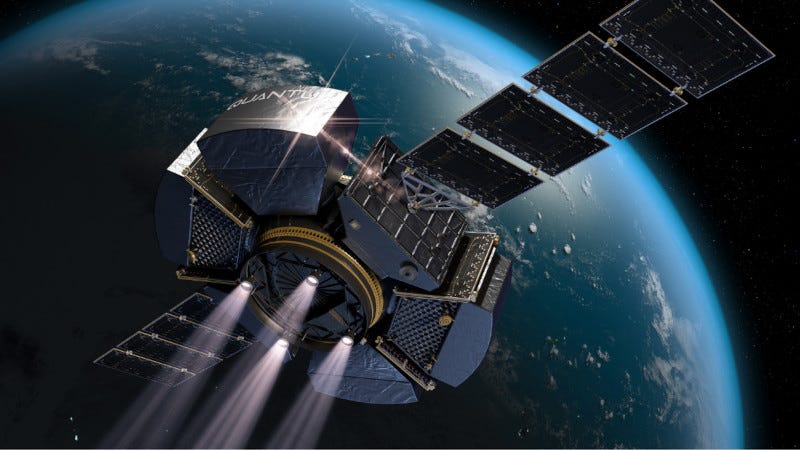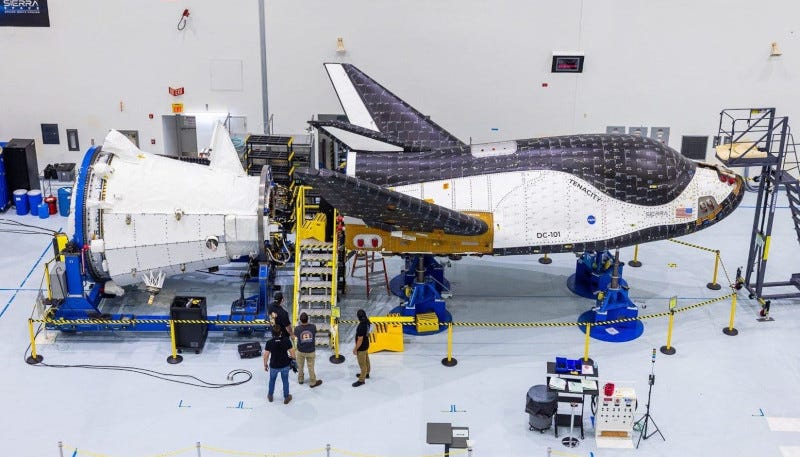A technology that allows a single system to operate in both high-thrust chemical and high-efficiency electric modes has been acquired by Quantum Space. This strategic acquisition from Phase Four, which also includes an integration and test facility in Los Angeles, strengthens Quantum Space’s ability to deliver highly maneuverable, persistent, and cost-efficient platforms for its national security, civil, and commercial customers and enabling missions from low-Earth to geostationary orbit and on to and cislunar space.
Phase Four’s multi-mode capability expands the utility of the Quantum Space Ranger platform. It combines rapid maneuvering for responsive missions with efficient station-keeping and phasing, and simplifies refueling by using a single propellant. This added agility supports faster response times, more versatile mission profiles, and longer-duration presence in orbit.
The newly acquired Los Angeles facility positions Quantum Space in a central hub of the nation’s space industrial base. The facility includes a large high-bay integration area, advanced environmental test chambers, machine shops, clean room, and a mission development laboratory.
-0-
Financial results for the second quarter ended June 30, 2025 have been released by Firefly Aerospace. The results are the first to be released by Firefly following it’s IPO last month, which CEO Jason Kim said “reflects the bold culture of our generational company, which delivers on the most challenging missions in space.”
During the company’s second fiscal quarter, Kim testified before Congress on the success of Blue Ghost Mission 1 and the critical future of NASA’s Commercial Lunar Payload Services (CLPS) initiative. During the earnings call posted to the Firefly website, Kim outlined details of their next three planned lunar missions.
“Blue Ghost Mission 2, values at $130 million, will deliver our lander to the far side of the moon, marking the first such mission by a U.S. lander. The structures for this mission have entered assembly in our spacecraft cleanroom after completing their crucial integration readiness review earlier this year,” Kim said. “The first payloads arrived, with Australian company Fleet Space delivering its Spider payload, and NASA’s Jet Propulsion Laboratory delivering their user terminal. We are also conducting SPECTER engine testing in preparation for Blue Ghost Mission 2. In December, NASA awarded Firefly’s third Blue Ghost contract, valued at $180 million. Our team completed the systems requirements review, allowing us to move forward with the design and development of the lander system. And as you will hear more about later, NASA awarded a $177 million contract for Blue Ghost Mission 4 in July. All of these missions support the growing NASA CLPS initiative which recently received a $250 million budget increase for FY 2026.”
Firefly expects FY 2025 full-year revenue to be between $133 million and $145 million.
-0-
A strategic transition for the Dream Chaser spaceplane has been announced by Sierra space. Dream Chaser’s first flight will be a free-flyer, demonstration mission, which is expected to prove the technology and deliver critical data to NASA.
Sierra Space is prioritizing first-flight readiness with Dream Chaser, targeting a launch in late 2026 to align with expected launch vehicle availability. Sierra Space and NASA worked together to reach this mutually beneficial agreement that provides greater mission flexibility for Dream Chaser’s first flight. This flight aims to demonstrate critical capabilities for NASA’s ISS resupply and future Commercial LEO Destinations (CLD) missions and position Dream Chaser as a national asset available for future national security and defense demonstrations.
The company says they believe in Dream Chaser’s adaptability as an orbital, hypersonic spacecraft and rapid deployment, commercial testbed is critical to addressing the nation’s evolving priorities and emerging threats.
-0-
Coming up, a power deal for Astro Digital. But right now, why not take a minute to become a paid subscriber to The Journal of Space Commerce. Whether you’re a space professional, investor or an enthusiast, paid subscribers have first access to premium articles and podcasts focused on the new space economy. Just visit www.exterrajsc.com on Substack, and help keep The Journal of Space Commerce independent as we chronicle, cajole and, when necessary, critique the commercial space industry.
-0-
Satellite manufacturer Astro Digital has signed an agreement with startup Star Catcher to buy power in support of their “mission-as-a-service” model.
This partnership enables ESPA-class platforms like Astro Digital’s Corvus XL to scale from single-kilowatt buses to 10+ kW powerhouses, without expanding the satellite’s footprint. Jointly offering this capability means customers can have more powerful and cost effective missions, from single satellites to full constellations.
Star Catcher CEO Andrew Rush said the Astro Digital deal is an important one for the company.
(Andrew Rush) The deal that we’ve done with Astro Digital, namely them entering into a power purchase agreement with us is a big deal for us at Starcatcher because they’re one of the first customers just to sign up and say, hey, we’re gonna use this power beaming service and we’re actually gonna put some ready money on the table to reserve the utilization of this going forward. And this is a big validator for us, right? This is an even stronger sort of mission pull signal, market pull signal, showing that folks really value and want to use a power rated space.
(Ex Terra Media) Is this something that you’re getting a lot of traction on? Are you hearing from other folks that are at least interested if not ready to put pen to paper yet? So that’s right.
(Andrew Rush) We’ve had a lot of activity, a lot of interest, a lot of velocity that’s only gotten faster over the last year. I think when I was last on the podcast, we had maybe a dozen letters of intent signed from various folks and we had not yet inked any of these power purchase agreements. We now have more than three dozen letters of intent signed and we have multiple power purchase agreements signed with various firms. And we’ll be announcing those in the coming, in the future.
(Ex Terra Media) We were talking offline just a little bit about your upcoming demonstration at Kennedy Space Center. What’s that going to involve and what’s your timeline on it?
(Andrew Rush) We are on the doorstep of our largest ground-based demonstration of power beaming yet.
We really take a crawl, walk, run approach to technology development at StarCatcher. We start in the lab and then we do integrated tests and then we went to the Jacksonville Jaguars football stadium and did a 100 meter demonstration. We’ve done some kilometer scale validation of the technology more recently.
And in October, we’re going to go down to the shuttle landing facility and use the four and a half kilometer runway there to do a multi kilowatt, multi kilometer optical power beaming test campaign. And then once that test campaign concludes, then we will, you know, we’ll be sharing the results thereafter.
This announcement comes on the heels of Star Catcher’s $12.25 million Seed Round in July 2024, and a successful power beaming demonstration at the Jacksonville Jaguars’ EverBank Stadium, in March 2025. The company is gearing up for a large-scale demonstration at Space Florida’s Launch and Landing Facility later this year
-0-
The 2025 Fast Company Innovation by Design Awards have recognized the Kayhan Space Satcat space traffic management platform. Satcat was the only space project honored across all categories this year, highlighting the growing importance of user-centric design in the space industry.
Kayhan developed Satcat to address one of spaceflight’s most urgent challenges: traffic coordination in increasingly congested Earth orbit. Hyun Seo is the Chief Product Officer at Kayhan Space. He developed the Satcat software.
“We’re striving to be the best Space Object catalog. And how we do that is through several different facets. One is the public aspect, where people can go look up certain satellites. And there are many websites that do that, but I think what is very nice about Satcat is indexed so you can search by orbital parameters or by metadata like who owns it, or what businesses own it. And then the other aspect is, behind a login, both free and paid actually, we provide to satellite operators conjunction analysis tools for them to do risk assessment as well as actual mitigation.”
Seo says data on satellites is gathered from multiple sources.
“We have partner networks that we work with for, I think the proper term is uncooperative RSOs like debris, for example. Or RSOs that you just can’t contact the operator for. And then we would do our own orbit determination, as well as just slightly post-processing to get it into the system. And obviously the owner-operators can upload their own ephemera that they generate from their GPS and GNSS data.”
An RSO is a Residential Space Object. Kayhan Space will be featured on The Journal of Space Commerce Podcast on October 16th.
-0-
A new report titled “Redshift: The Acceleration of China’s Commercial and Civil Space Enterprise and the Challenge to America” has been released by the Commercial Space Federation.
The report offers a thorough review of China’s civil and commercial space activities over the past decade following the announcement of their “Space Dream” and implementation of the Belt and Road Initiative. Redshift outlines China’s plans and policy pronouncements, highlights achievements realized by 2025, and assesses the resulting risks to American commercial and strategic interests during this period of intensifying competition between the U.S. and China in orbit.
This report provides an open-source compendium and analysis of China’s goals and progress across six sectors of the space ecosystem: Spaceports and Infrastructure // Launch and Reentry // Remote Sensing (RS) and Space Situational Awareness (SSA) // Satellite Communications (Satcom) and Positioning, Navigation, and Timing (PNT) // Commercial Low Earth Orbit (LEO) // and Space Exploration.
The report was developed in collaboration with Arizona State University (ASU) and led by ASU NewSpace Initiative Research Analyst Jonathan Roll with support from BryceTech and Orbital Gateway Consulting.
-0-
In depth this week, two technology titans are poised to compete for a share of a market that will reshape global communications infrastructure. Amazon’s Project Kuiper is edging closer to commercial deployment while SpaceX’s Starlink will continue to accelerate its global expansion, setting the stage for a scenario that institutional investors may not be able to afford to ignore.
The global satellite market has reached an inflection point, with analysts projecting explosive growth from just over $362 billion in 2025 to approximately $729 and-an-half billion by 2034, representing a compound annual growth rate of just over 8 percent. More specifically, the satellite mega-constellations market is projected to surge from $5 and-a-half billion in 2025 to $27.3 billion by 2032, exhibiting a remarkable CAGR of just over 25.5%.
The mega-constellation sector, represented by companies like Kuiper and Starlink, exhibits classic infrastructure investment characteristics that institutional investors seek: high barriers to entry, natural monopoly tendencies, and strong network effects.
Starlink’s vertical integration strategy, leveraging SpaceX’s launch capabilities, has created significant cost advantages. Its phased-array antenna technology delivers latency around 20-40 milliseconds with speeds commonly ranging from 100-250 Mbps. More critically, the service has achieved proof-of-concept for next-generation capabilities.
Amazon’s Project Kuiper represents a different strategic approach, leveraging the company’s existing cloud infrastructure and enterprise relationships. With 102 satellites in orbit as of August 2025 and aiming for 3,236 total satellites, Kuiper expects to launch its commercial service by the end of this year. Kuiper’s integration with Amazon Web Services (AWS) creates unique value propositions for enterprise customers. This ecosystem approach could prove particularly attractive to large organizations already invested in AWS infrastructure.
The next five years will determine which operators achieve sustainable competitive positions in the NGSO market. An estimated 70,000 LEO satellites are expected to be launched over the next five years, representing unprecedented growth in space-based infrastructure.
The integration of artificial intelligence and machine learning capabilities into satellite operations could create new service categories and revenue opportunities. Advanced beam-forming technology and dynamic spectrum management will enable more efficient satellite utilization and improved service quality.
Paid subscribers can read the full analysis on The Journal of Space Commerce under the “In Depth” tab.
-0-
And those are some of the top stories we covered for you on The Journal of Space Commerce this week. Space Commerce Week is a production of Ex Terra Media. You can get daily updates on space commerce by subscribing to The Journal of Space Commerce on Substack at www.exterrajsc.com. And please consider becoming a paid subscriber. Whether you’re a space professional, investor or an enthusiast, paid subscribers have first access to premium articles and podcasts focused on the new space economy. Just visit www.exterrajsc.com and help keep The Journal of Space Commerce independent as we chronicle, cajole and, when necessary, critique the commercial space industry.
Theme Stock Music provided by CoolTones, from Pond5
You Might have Missed:



















